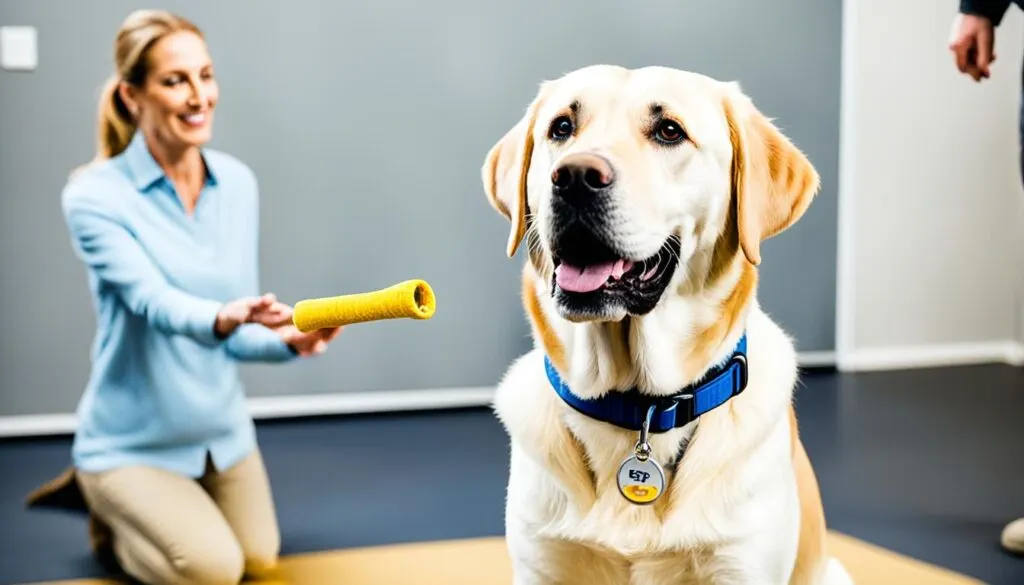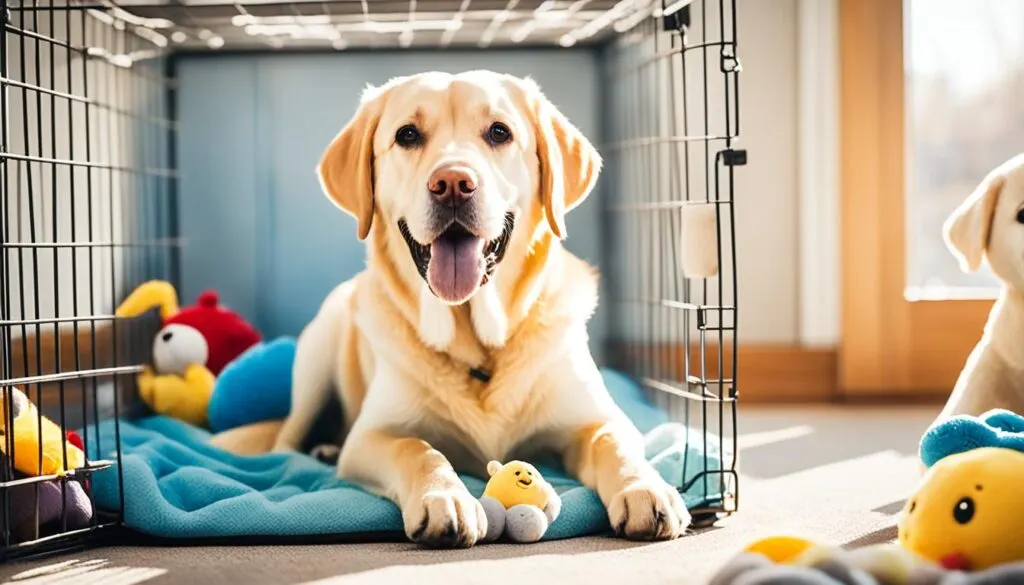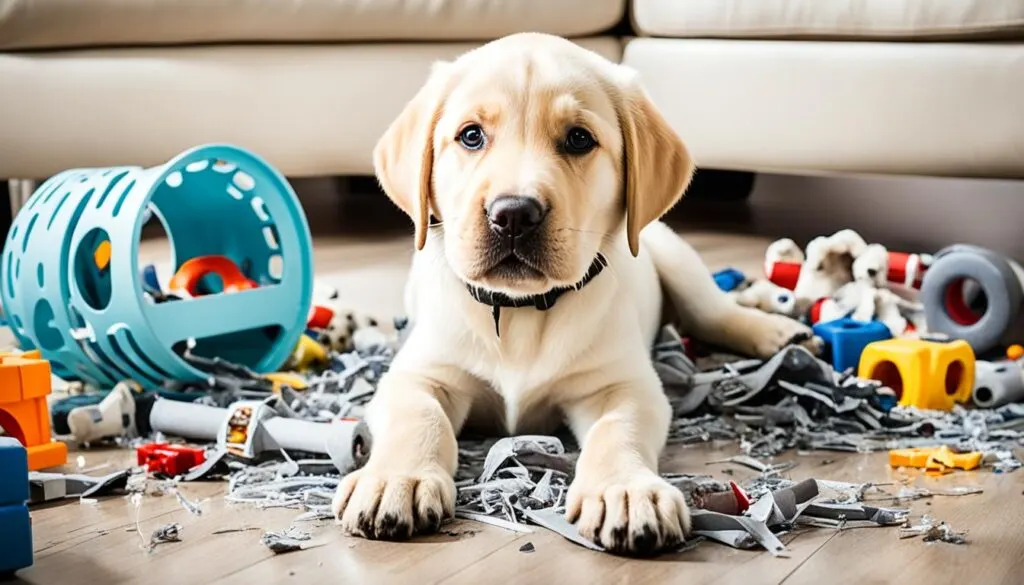Did you know that Labradors are one of the most popular dog breeds globally, universally loved for their friendly nature and intelligence?
However, despite their many positive qualities, training a Labrador can present unique challenges that require patience, consistency, and a deep understanding of their breed-specific needs.

Click Here to Jump to a Section
Key Takeaways:
- Labrador Retrievers are one of the most popular dog breeds worldwide.
- Training a Labrador requires patience, consistency, and breed-specific knowledge.
- Understanding Labrador behavior is essential for effective training.
- Establishing basic obedience commands forms the foundation of Labrador training.
- Leash reactivity, separation anxiety, and destructive behavior are common challenges faced by Labrador owners.
Understanding Labrador Behavior
Before delving into the specific challenges of training a Labrador, it’s essential to have a deep understanding of their behavior.
Labradors are intelligent and energetic dogs known for their friendly and outgoing nature.
By understanding their natural instincts and tendencies, you can tailor your training approach to effectively communicate with your Labrador and foster their development.
Labradors are social animals and thrive on companionship.
They are known for their loyalty and desire to please their owners, which makes them highly trainable.
However, they can also exhibit certain behaviors that may require attention and training.
Labradors are known for their strong retrieving instincts, a trait bred into the breed as they were originally bred as retrieving dogs for fishermen.
This instinct may manifest in behaviors such as picking up objects and carrying them around, even if they don’t belong to them.
Additionally, Labradors have a propensity for chewing.
Whether it’s out of curiosity, teething, or simply boredom, Labradors often explore the world through their mouths.
Providing appropriate chew toys and redirecting their chewing behavior is crucial to prevent destructive habits.
Socialization is another vital aspect of Labrador behavior.
Labrador puppies need positive exposure to a variety of people, animals, and environments from an early age to ensure they grow up to be well-adjusted and confident adult dogs.
Proper socialization helps prevent fear and aggression issues later in life.
Understanding Labrador behavior is essential for successful training.
By recognizing their inherent instincts and needs, you can tailor your training methods to address specific behaviors and ensure a harmonious relationship with your Labrador.
Establishing Basic Obedience Commands
Establishing basic obedience commands is essential for every Labrador owner.
These commands lay the foundation for a well-behaved, obedient, and happy Labrador.
In this section, we will explore the fundamental obedience commands that every Labrador should learn, along with Labrador training tips to make the process effective and enjoyable.
1. Sit Command
Teaching your Labrador to sit is one of the most basic and important commands. It helps your Labrador learn impulse control and is the basis for many other commands.
Here’s how you can teach your Labrador to sit:
- Hold a treat above your Labrador’s nose.
- Move the treat slowly towards the back of their head, which will cause them to lower their bottom.
- As soon as their bottom touches the ground, say “sit,” and give them the treat as a reward.
- Repeat this process, gradually phasing out the treat so that your Labrador responds to the verbal command alone.
Consistency and positive reinforcement are key when teaching the sit command. Practice in different environments to reinforce the command in various situations.
2. Stay Command
The stay command is crucial for keeping your Labrador in place and preventing them from running off or getting into dangerous situations. Here’s how you can teach your Labrador to stay:
- Start by asking your Labrador to sit.
- Show your open palm and say “stay” while taking a step back.
- If your Labrador remains in the sitting position, reward them with praise and a treat.
- Gradually increase the distance and duration of the stay command, rewarding them for successful stays.
Remember to release your Labrador from the stay command by using a release cue like “okay” or “release” to indicate that they can move.
3. Leash Training Techniques
Proper leash training is essential for both your Labrador’s safety and enjoyment during walks. Here are some Labrador training tips to make leash training effective:
- Choose a well-fitting collar or harness for your Labrador.
- Introduce the leash gradually, allowing your Labrador to sniff and get accustomed to it.
- Start with short walks in a low-distraction environment, rewarding your Labrador for walking beside you.
- Use positive reinforcement to encourage good leash manners and correct any pulling or tugging behaviors.
A well-trained Labrador that walks calmly on a leash will make your outings more enjoyable and stress-free.

Incorporating these basic obedience commands into your Labrador’s training routine is essential for their development and well-being.
Consistency, patience, and positive reinforcement are key to successful Labrador training. With these foundational commands, you’ll be on your way to having a well-behaved and obedient Labrador.
Dealing with Labrador Leash Reactivity
Leash reactivity is a common challenge faced by many Labrador owners. It can be frustrating and overwhelming when your beloved furry friend reacts aggressively or pulls excessively while on a leash.
However, with the right strategies and training techniques, leash reactivity can be managed and overcome.
Understanding the Causes of Leash Reactivity
Labrador leash reactivity can stem from various factors, including fear, anxiety, lack of socialization, or past negative experiences. It is essential to identify the root cause of your Labrador’s reactivity to better address the issue.
Managing and Overcoming Leash Reactivity
To manage leash reactivity, it’s crucial to focus on positive reinforcement training techniques.
Here are some effective strategies to help your Labrador walk calmly on a leash:
- Desensitization and Counterconditioning: Gradually expose your Labrador to the triggers that cause reactivity, such as other dogs or distractions, while rewarding calm behavior with treats and praise.
- Redirecting Attention: Teach your Labrador to focus on you during walks by using verbal cues, treats, or toys to redirect their attention away from potential triggers.
- Engage in Obedience Training: Strengthening your Labrador’s obedience skills through consistent training will enhance their ability to follow commands and remain focused on you during walks.
- Use Proper Equipment: Choose a suitable leash and harness that provides control and comfort for both you and your Labrador. Avoid using retractable leashes, as they can contribute to pulling and reactivity.
Consistency, patience, and positive reinforcement are key when training your Labrador to overcome leash reactivity.
It may take time and effort, but with perseverance, you can achieve significant improvements in their behavior while walking on a leash.
An Illustrative Comparison of Leash Reactivity Approaches
| Approach | Pros | Cons |
|---|---|---|
| Positive Reinforcement Training | – Builds trust and positive associations – Rewards desired behavior – Increases obedience and focus | – Requires time and consistency – May not yield immediate results – Not effective for severe reactivity cases |
| Punishment-based Training | – May provide immediate results in some cases – Releases frustration in the short term | – Creates fear and anxiety in the long term – Damages the human-dog bond – Potentially worsens reactivity and aggressive behavior |
| Combination Approach | – Integrates positive reinforcement with controlled exposure – Gradual desensitization to triggers – Addresses underlying behavioral issues | – Requires professional guidance – Time-consuming process – May not suit every dog’s temperament |
Crate Training Labrador Retrievers
Crate training is an essential aspect of raising a well-behaved Labrador. Introducing your Labrador to a crate can provide them with a safe and comfortable space while aiding in housebreaking and preventing destructive behaviors.
To start crate training your Labrador, follow these helpful tips:
- Choose the right crate: Select a crate that is large enough for your Labrador to stand, turn around, and lie down comfortably. Use a sturdy and well-ventilated crate that provides security and doesn’t have any sharp edges that could harm your pet.
- Introduce the crate gradually: Make the crate a positive and inviting space for your Labrador. Place a soft bed or blanket inside along with some favorite toys and treats. Allow your Labrador to explore the crate at their own pace. Encourage them with praise and rewards whenever they enter or show interest in the crate.
- Associate the crate with positive experiences: Make the crate a pleasant place for your Labrador. Feed them their meals near the crate or inside it to create positive associations. Give them special treats that they only receive when in the crate. This helps your Labrador to see the crate as a rewarding and secure space.
- Establish a routine: Introduce a consistent schedule for crate time, including mealtime, playtime, and rest time inside the crate. This will help your Labrador learn to anticipate and enjoy their time spent in the crate. Gradually increase the duration they spend in the crate, starting with short intervals and gradually lengthening it.
- Use positive reinforcement: When your Labrador enters the crate willingly, provide praise and treats to reinforce their good behavior. Avoid using the crate as a form of punishment, as this can create negative associations and make crate training more challenging.
- Be patient and consistent: Crate training takes time and patience. Stay consistent with the training routine and reward positive behavior. Avoid rushing the process and give your Labrador time to adjust and feel comfortable in their crate.
Remember, crate training is not only for housebreaking but also benefits your Labrador’s overall well-being and safety. A crate provides a secure place for them when you cannot supervise them, ensuring they remain out of harm’s way and preventing destructive behaviors.
Introducing crate training to your Labrador may require some time and effort, but it is a valuable investment in their development and the harmony of your home.

| Benefits of Crate Training Labrador Retrievers | Tips for Successful Crate Training |
|---|---|
| 1. Provides a safe and secure space for your Labrador | 1. Choose the right crate size and type |
| 2. Aids in housebreaking and potty training | 2. Gradually introduce the crate and make it inviting |
| 3. Prevents destructive behaviors when unsupervised | 3. Associate the crate with positive experiences |
| 4. Reduces anxiety and stress in your Labrador | 4. Establish a routine and consistency |
| 5. Facilitates travel and transportation | 5. Use positive reinforcement and avoid punishment |
With these crate training tips, you can create a positive and comfortable environment for your Labrador, helping them become a well-behaved and happy companion.
Tackling Labrador Barking Problems
Excessive barking can be a common challenge when it comes to Labrador training.
Understanding the reasons behind Labrador barking is crucial in order to effectively address and manage this behavior.
Labrador barking can be caused by various factors, such as fear, boredom, or territorial instincts.
To tackle Labrador barking problems, it is important to implement proper training techniques and strategies. Here are some effective methods that can help:
- Identify the underlying cause: Determine the root cause of your Labrador’s excessive barking. Is it triggered by fear or anxiety? Or is it simply a response to boredom or the need for attention?
- Provide mental and physical stimulation: Make sure your Labrador’s needs for both exercise and mental stimulation are met. Engage them in interactive games, provide puzzle toys, and take them for regular walks or play sessions.
- Positive reinforcement training: Use positive reinforcement techniques to reward your Labrador for quiet and calm behavior. Reward them with treats, praise, or play when they are not barking excessively.
- Desensitization and counter-conditioning: If your Labrador barks excessively due to fear or anxiety, gradually expose them to the triggering stimuli in a controlled and positive manner. Pair the presence of the trigger with rewards or calming techniques to change their emotional response.
Remember to be patient and consistent when addressing Labrador barking problems.
It may take time and effort to modify their behavior effectively. Seeking professional guidance from a dog trainer or behaviorist can also be beneficial in dealing with excessive barking in Labradors.
Expert Tip:
If your Labrador’s excessive barking persists despite your efforts, consult with a veterinarian to rule out any underlying medical conditions that may be contributing to the behavior.
Handling Labrador Separation Anxiety
Labrador Retrievers are known to be prone to separation anxiety.
This condition occurs when dogs become distressed or anxious when separated from their owners.
It can manifest in various ways, such as excessive barking, destructive behavior, or even physical symptoms like trembling or panting.
There are several common signs that indicate your Labrador may be experiencing separation anxiety:
- Persistent distress: Your Labrador becomes visibly anxious or distressed when you’re about to leave home or are already gone.
- Attention-seeking behavior: Your Labrador constantly seeks attention, follows you excessively, or exhibits clingy behavior.
- Destructive behavior: Your Labrador destroys furniture, shoes, or other household items when left alone.
- Excessive barking or howling: Your Labrador barks or howls excessively when separated from you, often persistently until you return.
- Potty accidents: Your Labrador may urinate or defecate inside the house while left alone, even if they are house trained.
It’s important to address separation anxiety in Labradors to prevent it from escalating and to ensure your dog’s emotional well-being. Here are some tips to help your Labrador cope with being alone:
- Gradual desensitization: Gradually expose your Labrador to periods of separation, starting with short durations and gradually increasing them. This helps them build confidence and reduces anxiety.
- Create a safe space: Provide a designated area where your Labrador feels secure and comfortable. This can be a crate, a specific room, or even a cozy corner with their favorite bedding and toys.
- Use positive reinforcement: Reward your Labrador with treats, praise, or interactive toys when they exhibit calm behavior during moments of separation.
- Establish a routine: Stick to a consistent daily routine, including regular feeding times, exercise sessions, and alone time. A predictable schedule can help your Labrador feel more secure and reduce anxiety.
Remember that every Labrador is unique, and the severity of separation anxiety can vary.
If you’re struggling to manage your Labrador’s separation anxiety on your own, consider seeking guidance from a professional dog trainer or behaviorist.
They can provide tailored advice and techniques to help your Labrador overcome their anxiety and thrive.
By addressing Labrador separation anxiety with patience, consistency, and positive reinforcement, you can help your furry friend feel more secure and confident when left alone.
Remember to practice empathy and understanding during this process, as anxiety can be a challenging experience for your Labrador.

Addressing Labrador Chewing and Destructive Behavior
Labradors are known for their love of chewing, but when their chewing becomes destructive, it can be a frustrating challenge for owners.
Understanding the reasons behind excessive chewing and implementing effective strategies can help redirect their behavior and prevent damage to your belongings.
Labrador chewing is a natural instinct rooted in their genetics.
Just like their ancestors, Labradors have a strong urge to chew as a way to explore their environment, relieve teething discomfort, and alleviate boredom or anxiety.
However, this behavior can result in destructive habits if not properly managed.
To address Labrador chewing and destructive behavior:
- Provide appropriate chewing outlets: Ensure your Labrador has access to a variety of safe and durable chew toys. This will redirect their chewing behavior away from your furniture, shoes, or other household items. Look for toys designed specifically for heavy chewers, such as sturdy rubber toys or dental chews.
- Supervise and manage their environment: When you cannot directly supervise your Labrador, confine them to a safe area or use a crate to prevent access to objects they may chew on. Gradually increase their freedom as they demonstrate appropriate chewing behavior with their toys.
- Apply taste deterrents: If your Labrador consistently targets specific items, you can use taste deterrent sprays or gels on those objects. These products have bitter or unpleasant tastes that discourage chewing.
- Keep them mentally stimulated: Boredom can contribute to chewing behavior. Provide mental stimulation through interactive toys, puzzle feeders, or training sessions to keep your Labrador engaged and mentally satisfied.
- Ensure regular exercise and enrichment: Labradors are highly energetic dogs, and insufficient exercise or mental stimulation can lead to excessive chewing. Regular walks, playtime, and activities that challenge their problem-solving abilities will help tire them out and reduce their chewing tendencies.
By implementing these strategies consistently and providing your Labrador with appropriate outlets for their chewing instincts, you can effectively address their chewing behavior and prevent destructive habits.
Remember to be patient and consistent in your training efforts, and seek professional guidance if the behavior persists.

Comparison of Chewing Toys for Labradors
| Toy Name | Features | Durability | Recommended for |
|---|---|---|---|
| KONG Classic Dog Toy | Durable rubber, can be stuffed with treats | Very durable | Heavy chewers |
| Nylabone Dura Chew Flavored Dog Bone | Long-lasting, flavored bone | Durable, but not indestructible | Moderate chewers |
| Outward Hound Hide-A-Squirrel | Plush puzzle toy with hidden squeaky squirrels | Moderate durability (supervised play recommended) | Light to moderate chewers |
Socializing Your Labrador
Proper socialization is a vital aspect of raising a well-behaved and confident Labrador.
Socializing your puppy from an early age sets the foundation for their behavior and temperament throughout their lives.
Labrador socialization involves introducing them to various environments, people, and animals in a positive and controlled manner.
Early socialization helps your Labrador develop good manners, reduces the risk of behavioral issues, and ensures they can adapt to new situations with ease.
Start socializing your Labrador puppy as soon as they have received their vaccinations and are cleared by your veterinarian.
Gradually expose your puppy to different sounds, sights, smells, and textures, so they can learn to navigate their world comfortably.
When introducing your Labrador to new people, encourage positive interactions by rewarding them for calm and friendly behavior. S
et up playdates with other well-behaved dogs to teach your Labrador appropriate social skills, such as sharing toys and understanding canine body language.
Remember to supervise all interactions to maintain safety and prevent any negative experiences.
Consistency and patience are key when socializing your Labrador.
Gradually increase the complexity of environments and situations your Labrador experiences to build their confidence.
By providing positive and controlled socialization experiences, you can help your Labrador become a well-rounded and socially adept companion.
